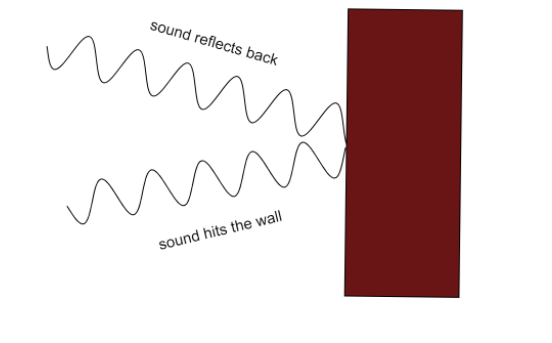
Echo is due to
(A) Reflection of sound
(B) Refraction of sound
(C) Both reflection and refraction of sound
(D) Diffraction of sound
Answer
119.7k+ views
Hint Just like light, the sound wave can reflect off surfaces too. Unlike light waves, sound waves have a very long wavelength. Thus, sound waves require a much bigger area to get reflected as compared to the light wave.
Complete step by step answer:

When a sound wave (longitudinal wave) occurs on a flat and hard surface, it reflects back. This phenomenon of reflection of sound is called echo. For this phenomenon, it is required that the reflecting surface should be much bigger as compared to the wavelength of the sound wave.
A reflected sound can be heard separately and distinctly from the source only if the source is very close to the listener and the reflecting surface is comparatively far from the listener.
Practically, this condition can be realized by the example that we often experience echoes near the mountain (where reflecting surface i.e. the mountains are very far) but if you stand in front of a wall and speak loudly, you don’t observe this phenomenon.
Additional Information
In the case of a numerical, you should keep in mind that the distance travelled by sound waves is double the distance between the source and reflecting surface. So, the velocity of sound can be given as
\[v = \dfrac{{2d}}{t}\]
Where, $d$ is the distance between the source and reflecting surface.
$t$ is the time taken to cover that distance.
Note
Keep in mind that any wave can undergo reflection, refraction, and diffraction. However, the conditions for these to happen depends on the wave. So if a light wave is diffracted by an object, it doesn’t necessarily mean that a sound wave will be diffracted too.
Complete step by step answer:

When a sound wave (longitudinal wave) occurs on a flat and hard surface, it reflects back. This phenomenon of reflection of sound is called echo. For this phenomenon, it is required that the reflecting surface should be much bigger as compared to the wavelength of the sound wave.
A reflected sound can be heard separately and distinctly from the source only if the source is very close to the listener and the reflecting surface is comparatively far from the listener.
Practically, this condition can be realized by the example that we often experience echoes near the mountain (where reflecting surface i.e. the mountains are very far) but if you stand in front of a wall and speak loudly, you don’t observe this phenomenon.
Additional Information
In the case of a numerical, you should keep in mind that the distance travelled by sound waves is double the distance between the source and reflecting surface. So, the velocity of sound can be given as
\[v = \dfrac{{2d}}{t}\]
Where, $d$ is the distance between the source and reflecting surface.
$t$ is the time taken to cover that distance.
Note
Keep in mind that any wave can undergo reflection, refraction, and diffraction. However, the conditions for these to happen depends on the wave. So if a light wave is diffracted by an object, it doesn’t necessarily mean that a sound wave will be diffracted too.
Recently Updated Pages
Difference Between Circuit Switching and Packet Switching

Difference Between Mass and Weight

JEE Main Participating Colleges 2024 - A Complete List of Top Colleges

JEE Main Maths Paper Pattern 2025 – Marking, Sections & Tips

Sign up for JEE Main 2025 Live Classes - Vedantu

JEE Main 2025 Helpline Numbers - Center Contact, Phone Number, Address

Trending doubts
JEE Mains 2025: Check Important Dates, Syllabus, Exam Pattern, Fee and Updates

JEE Main Login 2045: Step-by-Step Instructions and Details

Class 11 JEE Main Physics Mock Test 2025

JEE Main Chemistry Question Paper with Answer Keys and Solutions

JEE Main Exam Marking Scheme: Detailed Breakdown of Marks and Negative Marking

JEE Main Chemistry Exam Pattern 2025

Other Pages
JEE Advanced Marks vs Ranks 2025: Understanding Category-wise Qualifying Marks and Previous Year Cut-offs

NCERT Solutions for Class 11 Physics Chapter 7 Gravitation

NCERT Solutions for Class 11 Physics Chapter 1 Units and Measurements

NCERT Solutions for Class 11 Physics Chapter 9 Mechanical Properties of Fluids

Units and Measurements Class 11 Notes - CBSE Physics Chapter 1

NCERT Solutions for Class 11 Physics Chapter 2 Motion In A Straight Line




